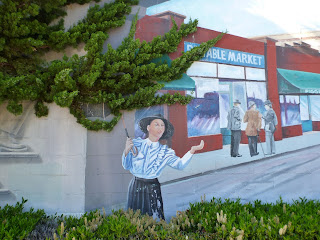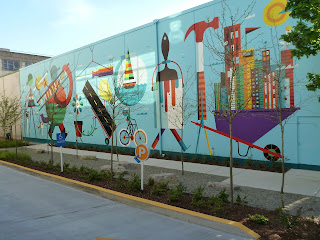Left: “Her Deepness” carved by Viktor in 2004 in honor of Deep Ocean Pioneer, Dr. Sylvia A. Earle – on the Google Campus; Right: “Oceanographic Technician” carved by Viktor in 2004 in honor of Legend of the Sea, Jacques Yves Cousteau.
A Noogler is a new Google employee. Typically, each Noogler spends his first week of employment in orientation at Google’s Mountain View headquarters. Travelmarx went through the experience. It’s fun, exciting, overwhelming, motivating, and much more. It’s a week of learning about the company and about yourself as you try on the new culture you have been hired into. In this blog post, I won’t go into detail about the orientation because it will ruin the surprise for you (and I suppose you are reading this because you are going) and the details will likely change over time. Instead, I’ll talk about some of the things and places that caught my attention. My manager to-be suggested I stay two weeks at orientation which meant I spent the weekend in the area and could explore a little more.
GBikes
During the week, I was smitten by the GBikes. You can use them to travel around Google’s spread-out campus. These bright yellow, blue, red, and green bike - what did you expect for colors? - are fun to ride and make you feel like a kid. Some call them clown bikes. You pick up a bike where you find it and drop it off at your final destination. It leads to some bikes being in the oddest of locations. No problem, little bike gremlins come around in the night and rebalance the bike distribution. You can borrow helmets from lobbies before you jump on the bikes. Read more on the bikes in this Wired article.
GBikes in Front of 1200 Charleston Rd, Mountain View
A Piece of the Berlin Wall
One day between orientation sessions, one of the guys we ate lunch with said: “hey I know where a piece of the Berlin Wall is close by.” That was enough for us to jump on our GBikes and go find it. The piece or more accurately, two pieces, were located at 2685 Marine Way, or thereabouts. It’s in a parking lot, not visible from the road. I didn’t realize so many of the segments of the Berlin Wall have been distributed around the world. One of the pieces, has a heart surrounding the words “Wir Liebe Dich” (We Love You).
A Piece of the Berlin Wall in Mountain View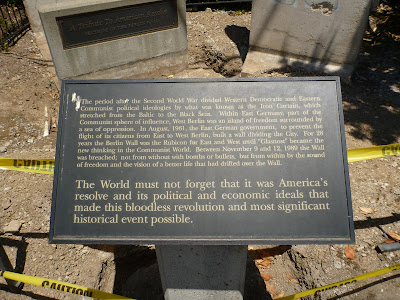
A Deborah Butterfield Horse
As I was riding between buildings (Crittenden to the Headquarters building) one day I saw a Deborah Butterfield horse grazing in a brown field along Crittenden Lane. The plaque below it reads “Cast Bronze Horse, Deborah Butterfield, May 2001, A Gift to the People of Mountain View, From SGI.” Friends tell me that Silicon Graphics (SGI) was once located in buildings now occupied by Google or at least in the area. Now, only the horse tells the story.
Left: Deborah Butterfield Horse on Crittenden Lane; Right: View of Google Campus Looking South from Vista Slope. Looking South
The Stevens Creek Trail
The Stevens Creek Trail, runs north and south, following the Stevens Creek. The trail starts just south of El Camino Real (California State Route 82) all the way to the San Francisco Bay. Just north of the Google campus, you can connect up the Permanente Creek Trail and trails leading the Palo Alto Baylands. I used the Stevens Creek Trial to ride back and forth to campus from my apartment in Mountain View.
Left: Stevens Creek Trail Bridge Near Moffett Field Boulevard and West Valley Freeway (85); Right: Stevens Creek Trial Near the Ames Substation
Left: View from Stevens Creek Trail Toward Moffett Field; Right: Snail on Rumex Near Shoreline Amphitheatre
The Palo Alto Baylands
Just a stone’s throw from the Google campus you will find the Baylands Nature Preserve. I borrowed a bike from the Google Bike Shop for the weekend and took off early on Saturday morning to explore the preserve. I ended up at the Lucy Evans Baylands Nature Interpretive Center, built on pilings at the edge of the salt marsh. Nobody was home and the building was not officially open, yet the door was open. Inside, there are some exhibits explaining the ecosystem of the marsh and the history of the area, but it was a bit of disappointment. Read the brochure online to get an overview. There are information plaques talking about plants and animals scattered throughout the preserve, but the preserve is too big to understand or appreciate in one visit.
Left: Water, Mud, Sky at the Palo Alto Baylands; Center: Palo Alto Baylands (Byxbee Park) Pylons; Right: James Moore – ‘Bliss in the Moment’ – Sculpture, Near Hawk Pond
Android Figures
One thing I’ll say about Google is that, like many tech companies, there is no shortage of code names for various products. The code names for the Android operation system are some of the catchiest. They are rendered larger than life outside of Building 44 on Charleston Road.
Left: Android Code Names in the Large; Right: A Loon Balloon at a TGIF Event
Stanford
If it all started at Stanford, Google that is, why not visit? The Google history page says that Larry Page and Sergey Brin met in 1995 at Stanford. Let’s see, I was already in a midlife crisis in 1995. Oh never mind me.
Back to Stanford. I’d never been there so a little campus sightseeing was in order. I first dropped by with Wild Dingo on Saturday. Then on Sunday, I rode over from Mountain View and tool a self-guided podcast tour, Plants, Animals, and Science Art on the Stanford Campus.
Left: Alexander Calder – ‘Le Faucon’ (1963); Center: Henry Moore – ‘Large Torso: Arch’ (1962-63); Right: Rodin - Burghers of Calais (1884 - 1895)
.JPG)
Stuff To Do in the Area as a Noogler
Admittedly, this list is skewed to my tastes, but here it goes:
- Filoli
- Computer History Museum
- Stanford
- Rengstorff House
- Moffett Field Museum
- Intel Museum (previous blog post: Intel Museum : Journey Through Decades of Innovation)
A Wall and a Portal: Metaphors for a Career Change? Left: A Piece of the Berlin Wall; Right: Garden Gate at Filoli.



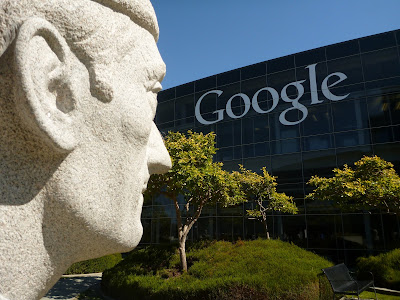



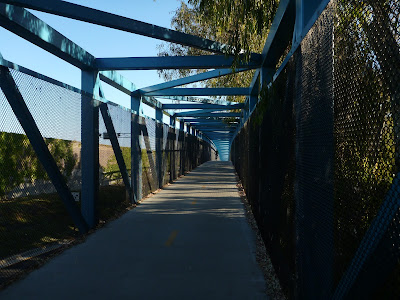




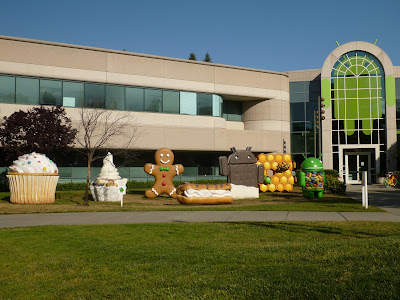
.JPG)






















